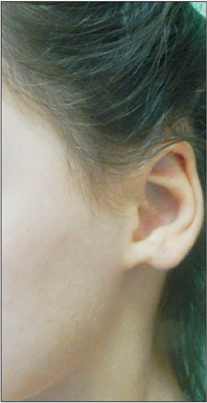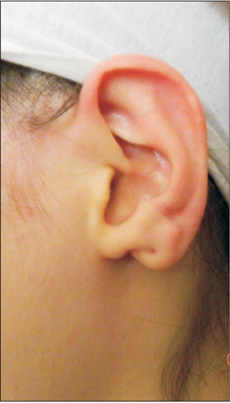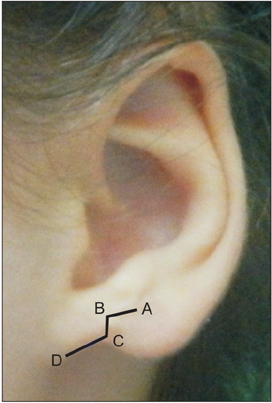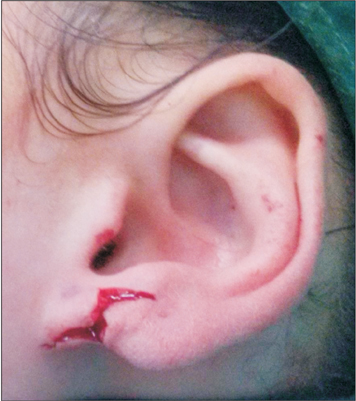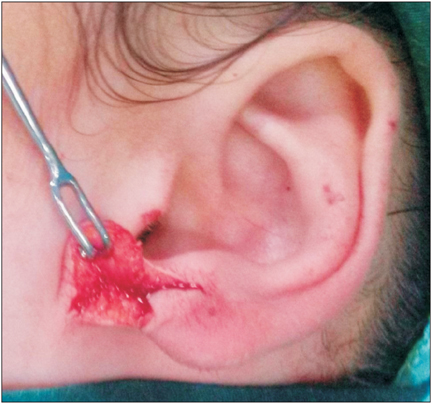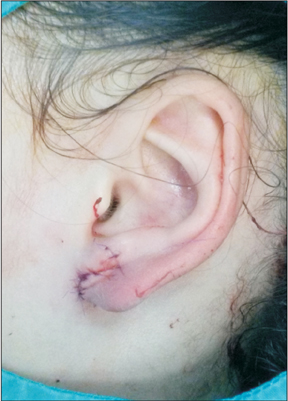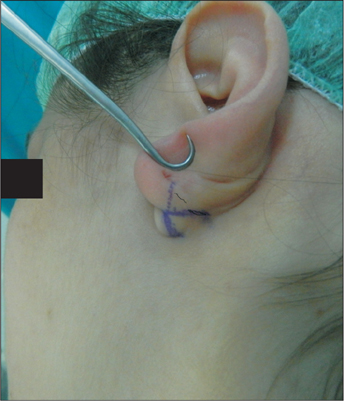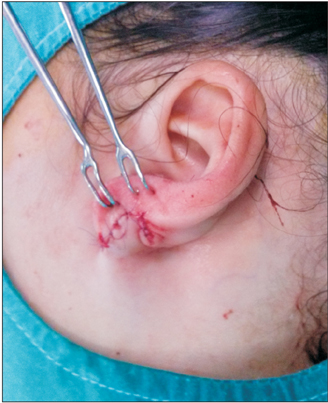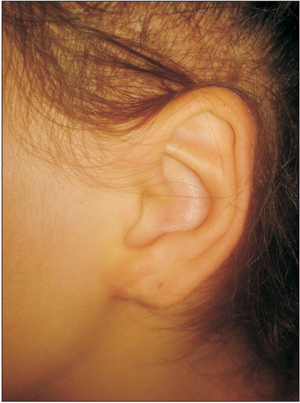J Korean Assoc Oral Maxillofac Surg.
2017 Dec;43(6):423-426. 10.5125/jkaoms.2017.43.6.423.
Correction of congenital cleft earlobe with front and back flaps
- Affiliations
-
- 1Department of Plastic Surgery, Kanuni Training and Research Hospital, Trabzon, Turkey. selmankaraci@gmail.com
- 2Department of Plastic Surgery, Recep Tayyip ErdoÄŸan University School of Medicine, Rize, Turkey.
- KMID: 2398998
- DOI: http://doi.org/10.5125/jkaoms.2017.43.6.423
Abstract
- Congenital auricular deformities may be either deformational or malformational. Malformational anomalies present with a skin or cartilage shortage. Two cases with congenital cleft earlobe were presented. A new surgical technique using a two-layered repair with front and back flaps were introduced. She waited to begin wearing earrings until six months after the surgery to prevent possible scar contracture. The patients were followed up for a period ranging from 3 to 14 months. The earlobe volume deficiency was replaced, and acceptable scar maturation was obtained.
Keyword
Figure
Reference
-
1. Conrad K, Reifen E. Congenital cleft ear lobe deformity: a staged reconstruction. J Otolaryngol. 1994; 23:19–22.2. Park C. Lower auricular malformations: their representation, correction, and embryologic correlation. Plast Reconstr Surg. 1999; 104:29–40.
Article3. Porter CJ, Tan ST. Congenital auricular anomalies: topographic anatomy, embryology, classification, and treatment strategies. Plast Reconstr Surg. 2005; 115:1701–1712.
Article4. Yotsuyanagi T, Yamashita K, Sawada Y. Reconstruction of congenital and acquired earlobe deformity. Clin Plast Surg. 2002; 29:249–255.
Article5. Fujiwara T, Matsuo K, Taki K, Noguchi M, Kiyono M. Triangular flap repair of the congenital earlobe cleft. Ann Plast Surg. 1995; 34:402–405.
Article6. Maral T, Tuncali D, Ozgür F, Gürsu KG. A technique for the repair of simple congenital earlobe clefts. Ann Plast Surg. 1996; 37:326–331.
Article7. Hwang K, Kim DH, You SH. Correction of congenital transverse cleft of the earlobe. J Craniofac Surg. 2011; 22:279–280.
Article8. Qing Y, Cen Y, Xu X, Chen J. A new technique for correction of simple congenital earlobe clefts: diametric hinge flaps method. Ann Plast Surg. 2013; 70:657–658.9. Okada E, Maruyama Y. A simple method for earlobe reconstruction. Plast Reconstr Surg. 1998; 101:162–166.
Article10. Zhang JY, Ha F. Congenital auricular deformity consisting of cleft concha and transposition of the earlobe and antitragus. Plast Reconstr Surg. 1996; 97:428–430.
Article
- Full Text Links
- Actions
-
Cited
- CITED
-
- Close
- Share
- Similar articles
-
- Surgical Correction Of Congenital Earlobe Cleft Using Reverse L-Plasty
- A One Stage Reconstruction of Defective Type Cleft Earlobe: Infra-auricular Transposition Flap
- Reconstruction of Defective Type Congenital Cleft Earlobe with S-shaped Flap
- Correction of the congenital earlobe cleft
- W-Shaped Triple V-Y Advancement Flaps for the Correction of Secondary Cleft Lip Nasal Deformity

